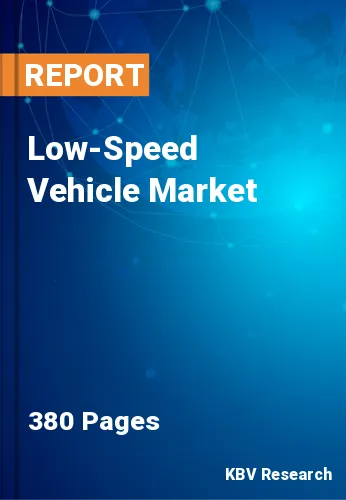The Global Low-Speed Vehicle Market size is expected to reach $16.3 billion by 2030, rising at a market growth of 7.2% CAGR during the forecast period.
Golf carts’ demand has increased in various industries, including hotels, weddings, amusement parks, travel destinations, airports, stadiums, security & patrols, and cargo transport; however, expanding golfing activity consumption continues to be the primary growth factor. Hence, Golf Carts are expected to register more than 28% share of the market by 2030. One of the main drivers for development is the growing demand for sustainable energy solutions, which is why golf carts are becoming increasingly popular.
The number of golf courses and country clubs is also increasing significantly to meet public demand, which is expected to drive up demand for golf carts globally. Further, the need for golf carts will increase due to the number of golf courses and people interested in the sport. For instance, according to the US National Golf Foundation, in 2022, more than one-third of Americans over the age of 5 played golf (on or off a course), watched golf online or on television, read about it, or even listened to a podcast about golf. This was 12% more than the year-on-year. Due to this, the market for low-speed vehicles saw a direct increase in demand for golf carts.
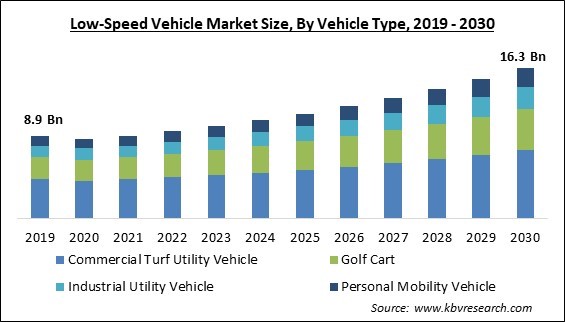
The major strategies followed by the market participants are Product Launches as the key developmental strategy to keep pace with the changing demands of end users. For instance, In June, 2023, Textron Specialized Vehicles introduced the Hauler Pro LSV and Tour LSV, two new Cushman utility models. Additionally, In June,2023, Toro introduced Vista, the golf cartlike shuttles for golf courses, resorts, and large campuses. This launch also fulfilled the company's existing customers' requirements.
Based on the Analysis presented in the Cardinal matrix, Deere & Company is the major forerunner in the Market. In February, 2023, John Deere unveiled the Z370R Electric ZTrak, its first electric zero-turn mower. This mower is an addition to the company's electric vehicle lineup of fairway and green mowers, a utility rake, and an electric version of the Gator utility vehicle for the sports field and golf course. The ZTrak's 58V, 3.2-kWh lithium-ion battery can be charged using a regular outlet, and it can mow about two acres on a single charge. Companies such as The Toro Company, KUBOTA Corporation, Yamaha Motor Co., Ltd. are some of the key innovators in the Market.
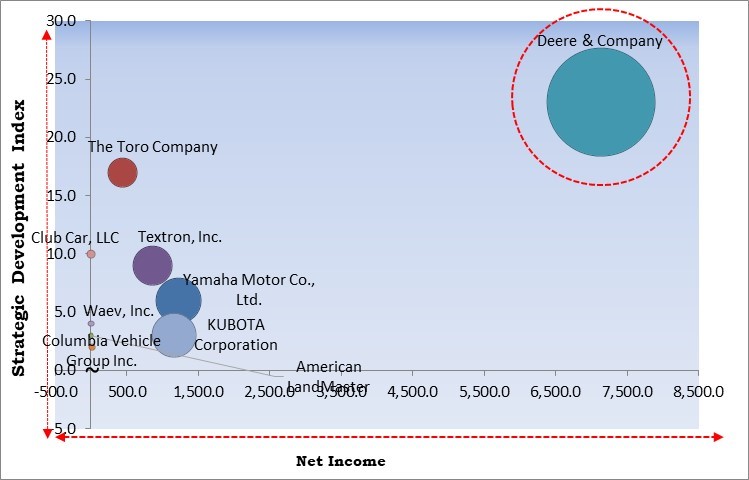
Urbanization is expected to rise gradually, and governments are expected to begin offering more appealing offers on electric vehicles, which will create lucrative opportunities for market growth. The growing desire for ecologically friendly automobiles, particularly on city streets for short commutes, is anticipated to fuel the market. Governments from different nations are concentrating on developing the infrastructure for electric vehicles, such as bicycle lanes, public charging stations, and others, as consumer interest in e-motors grows. Therefore, it is anticipated that all these aspects will provide the market with potential growth possibilities in the near future.
According to the India Brand Equity Foundation (IBEF), the real estate sector in India is predicted to reach $1 trillion by 2030 and account for 13% of the nation's overall GDP. LSV has been required for interior transit in large residential projects because of the wide area. The aviation industry is another commercial field that offers a chance to raise the demand for low-speed vehicles. As a result, during the anticipated term, the growth of real estate, hotels, and aviation may be the primary factors driving the market.
The majority of nations charge more to purchase electric cars than diesel or gasoline models. Because of this, it is difficult for the poorest households to quickly switch from (older) diesel and petrol cars to electric vehicles. Electronic vehicles are more expensive than traditional vehicles or conventional cars because of the expense of the battery and technology. The market is being held back from expanding due largely to the high cost of electric vehicles.
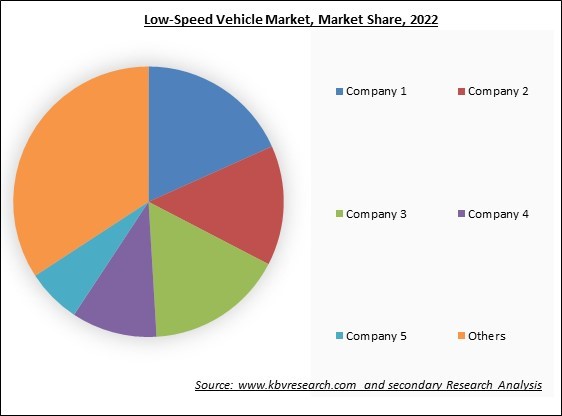
The leading players in the market are competing with diverse innovative offerings to remain competitive in the market. The above illustration shows the percentage of revenue shared by some of the leading companies in the market. The leading players of the market are adopting various strategies in order to cater demand coming from the different industries. The key developmental strategies in the market are Product Launches and Product Expansions.
Based on application type, the market is segmented into golf courses, hotels & resorts, airports, industrial facilities, and others. The golf courses segment registered the highest revenue share in the market in 2022. Golf is becoming a more well-liked sport globally, primarily responsible for the market's expansion. Additionally, low-speed golf carts have been allowed on public roads for personal transportation, which has fueled market’s expansion. A growing number of golf clubs now incentivize holders of packaged family membership cards, including kid-friendly settings, luxurious accommodations, fitness centers, and cutting-edge amenities to attract new members. This will increase demand for golf carts with sitting capacity of 2 to 8 people.
On the basis of vehicle type, the market is fragmented into golf cart, commercial turf utility vehicle, industrial utility vehicle, and personal mobility vehicle. The industrial utility segment acquired a substantial revenue share in the market in 2022. An industrial utility vehicle is intended for usage in factories, warehouses, and other places where workers must move quickly and efficiently. These vehicles are often used for moving people, goods, tools, and cleaning & maintenance tasks. These compact vehicles can be either gas or electric-powered. The industrial utility low-speed vehicle is intended for short journeys and low-speed transport.
By propulsion, the market is categorized into electric, diesel, and gasoline. The gasoline segment recorded a remarkable revenue share in the market in 2022. The internal combustion engines that power gasoline LSVs use gasoline as fuel. Because LSVs travel at lower speeds and are used less often than other vehicles, these engines are typically smaller and less powerful than those found in other vehicles.
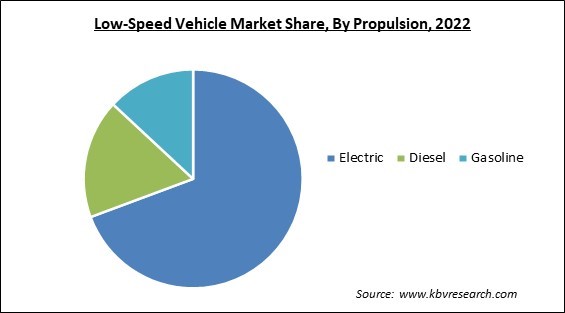
Based on power, the market is classified into <8 KW, 8-15 KW, and >15 KW. The >15 KW segment procured a promising growth rate in the market in 2022. The growing demand for more powerful and qualified vehicles is reflected in the >15KW LSVs. Traditional LSEVs were restricted to a top speed of 25 mph (40 km/h) and smaller power outputs, whereas >15KW LSEVs are intended to offer higher speeds and better performance.
By battery, the market is fragmented into li-Ion, and lead acid. In 2022, the li-Ion segment witnessed the largest revenue share in the market. The Lithium-ion (li-Ion) battery has significant demand for electric LSVs because of its benefits, including a longer travel distance, a better weight-to-performance ratio, a quicker self-discharge, fewer maintenance requirements, and less environmental impact.
Based on voltage, the market is categorized into <60 V, and >60 V. The >60 V segment projected a prominent revenue share in the market in 2022. In order to meet consumer demand, numerous companies have gone online, which has increased the number of mega distribution centers and warehouses around the world. This has increased the sales of electric commercial turf utility vehicles or industrial utility vehicles, that has, in turn, raised the demand for high-voltage batteries.
On the basis of category, the market is classified into L6, and L7. The L7 segment generated the highest revenue share in the market in 2022. A four-wheeled vehicle with a maximum continuous rated power of 15 kW and an unladen mass of no more than 400 kg (550 kg for goods-carrying vehicles), excluding the mass of the batteries in the case of electric cars. An example of the L7 category is microcars. The growing popularity of microcars is predicted to support the growth of the market in this segment.
| Report Attribute | Details |
|---|---|
| Market size value in 2022 | USD 9.4 Billion |
| Market size forecast in 2030 | USD 16.3 Billion |
| Base Year | 2022 |
| Historical Period | 2019 to 2021 |
| Forecast Period | 2023 to 2030 |
| Revenue Growth Rate | CAGR of 7.2% from 2023 to 2030 |
| Number of Pages | 380 |
| Number of Table | 713 |
| Report coverage | Market Trends, Revenue Estimation and Forecast, Segmentation Analysis, Regional and Country Breakdown, Competitive Landscape, Market Share Analysis, Companies Strategic Developments, Company Profiling |
| Segments covered | Category Type, Vehicle Type, Vehicle Type, Propulsion, Battery Type, Voltage Type, Application, Region |
| Country scope | US, Canada, Mexico, Germany, UK, France, Russia, Spain, Italy, China, Japan, India, South Korea, Singapore, Malaysia, Brazil, Argentina, UAE, Saudi Arabia, South Africa, Nigeria |
| Growth Drivers |
|
| Restraints |
|
Region wise, the market is analyzed across North America, Europe, Asia Pacific, and LAMEA. In 2022, the North America region led the market by generating highest revenue share. Due to favorable government regulations, reduced labor costs, and lower manufacturing prices, Mexico and Canada are witnessing growth. The region favors low-speed electric vehicles due to their zero carbon emissions and reduced noise.
Free Valuable Insights: Global Low-Speed Vehicle Market size to reach USD 16.3 Billion by 2030
The market research report covers the analysis of key stake holders of the market. Key companies profiled in the report include Textron, Inc., Deere & Company, Yamaha Motor Co., Ltd., The Toro Company, KUBOTA Corporation, Columbia Vehicle Group Inc. (Nordic Group of Companies, Ltd.), Waev, Inc., Club Car, LLC, American LandMaster, and Suzhou Eagle Electric Vehicle Manufacturing Co., Ltd.
By Category Type
By Vehicle Type
By Power Output
By Propulsion
By Battery Type
By Voltage Type
By Application
By Geography
The Market size is projected to reach USD 16.3 billion by 2030.
Growing construction and real estate industry are driving the Market in coming years, however, Electric low-speed vehicle costs are high restraints the growth of the Market.
Textron, Inc., Deere & Company, Yamaha Motor Co., Ltd., The Toro Company, KUBOTA Corporation, Columbia Vehicle Group Inc. (Nordic Group of Companies, Ltd.), Waev, Inc., Club Car, LLC, American LandMaster, and Suzhou Eagle Electric Vehicle Manufacturing Co., Ltd.
The Commercial Turf Utility Vehicle segment is generating the highest revenue share in the Global Low-Speed Vehicle Market by Vehicle Type in 2022 thereby, achieving a market value of $6.8 billion by 2030.
The Electric segment is leading the Global Low-Speed Vehicle Market by Propulsion in 2022 thereby, achieving a market value of $10.3 billion by 2030.
The North America market is generating highest revenue share in the Global Low-Speed Vehicle Market by Region in 2022 and would continue to be a dominant market till 2030; thereby, achieving a market value of $5.7 billion by 2030.
Our team of dedicated experts can provide you with attractive expansion opportunities for your business.
